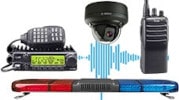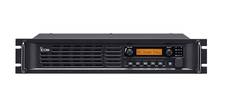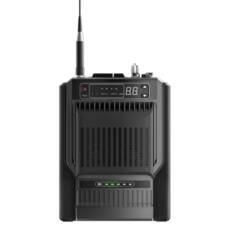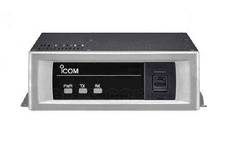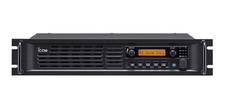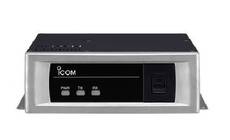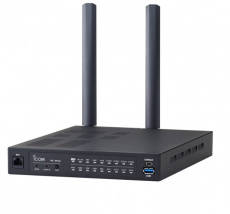Two-Way Radio Repeater
- further categoriesThe range of two-way radios is inherently limited, and often other circumstances make radio communication difficult. This can be the case if there is a lot of reinforced concrete or metal in an area, as these absorb radio signals. Read more...
• Frequency coverage: 136-174MHz
• 64 channel capacity (channel memory)
• Digital MotoTRBO TDMA or analogue operation
• 1-50W RF output power
• 100% continuous full duty cycle at 25W
• Supports two simultaneous voice or data paths in digital TDMA mode.
• Easy operation, LED displays
• 230Vac / 12Vdc input voltage, Integrated power supply
• Built-in 3A battery charger output
• Front panel USB port allows easy configuration
• Can be installed in 19' rack cabinet, 1U height
• Remot control via LAN port
• Price include RLN4152A cable
• Frequency coverage: 400-470MHz
• 64 channel capacity (channel memory)
• Digital MotoTRBO TDMA or analogue operation
• 1-50W RF output power
• 100% continuous full duty cycle at 25W
• Supports two simultaneous voice or data paths in digital TDMA mode.
• Easy operation, LED displays
• 230Vac / 12Vdc input voltage, Integrated power supply
• Built-in 3A battery charger output
• Front panel USB port allows easy configuration
• Can be installed in 19' rack cabinet, 1U height
• Remot control via LAN port
• Price include RKN4152A cable
• 19-inch rack-mountable, 2 unit high design with display
• Space for additional RF channel module
• Programmable between 136-174 MHz
• IDAS digital and analogue mixed mode
• 32 programmable channels, 5 programmable buttons
• Maximum 25W RF output power
• Upgradeable with optional control cards (Simulcast Conventional, Multi-site Conventional, Single site Trunking, Multi-site Trunking)
• Remote access via IP interface via optional UC-FR5300 IP card
• Can also be operated as a stand-alone repeater
• Programmable between 136-174 MHz
• IDAS digital and analogue mixed mode
• 32 programmable channels, 5 programmable buttons
• Maximum 25W RF output power
• Upgradeable with optional control cards (Simulcast Conventional, Multi-site Conventional, Single site Trunking, Multi-site Trunking)
• Remote access via IP interface via optional UC-FR5300 IP card
• 19-inch rack-mountable, 2 unit high design with display
• Space for additional RF channel module
• Programmable between 400-470 MHz
• IDAS digital and analogue mixed mode
• 32 programmable channels, 5 programmable buttons
• Maximum 25W RF output power
• Upgradeable with optional control cards (Simulcast Conventional, Multi-site Conventional, Single site Trunking, Multi-site Trunking)
• Remote access via IP interface via optional UC-FR5300 IP card
• Can also be operated as a stand-alone repeater
• Programmable between 400-470 MHz
• IDAS digital and analogue mixed mode
• 32 programmable channels, 5 programmable buttons
• Maximum 25W RF output power
• Upgradeable with optional control cards (Simulcast Conventional, Multi-site Conventional, Single site Trunking, Multi-site Trunking)
• Remote access via IP interface via optional UC-FR5300 IP card
• Radio over IP Gateway (RoIP)
• Create one system with IP telephones, analogue telephones and two-way radios
• Site-to-site and site-to-multisite radiocommunication
• Connect you radionetworks together even though they are on different locations
• Analogue and digital radios can be interconnected
• Audio in / out interfaces on the back
• RC-FS10 dispatcher software can be connected
• Connect external device (signal-lamp, gate-opener, etc)
• Supplied accessories: BC-236 AC adapter, antenna, antenna connector
• Programmable between 400-470MHz
• 1024 channel memory
• Designed to extend the communication range of DMR radios
• 1-25 W (high power version)
• 100% continuous operation even at the highest output power
• AC power and battery operation
• Easy operation, LED displays
• Automatic recognition between analogue and digital modes
• Can operate on AC power or optional battery, so can continue to operate in the event of a power failure
• GPS/GLONASS
• Over-the-air encryption
• IP54 dust and water resistance
• Programmable between 400-470MHz
• 1024 channel memory
• Designed to extend the communication range of DMR radios
• With installed duplexer
• 1-25 W (high power version)
• 100% continuous operation even at the highest output power
• AC power and battery operation
• Easy operation, LED displays
• Automatic recognition between analogue and digital modes
• Can operate on AC power or optional battery, so can continue to operate in the event of a power failure
• GPS/GLONASS
• Over-the-air encryption
• IP54 dust and water resistance
• Frequency range UHF: 400-470 MHz
• Channel capacity 64
• 100% continuous duty cycle from 5 W to 50 W
• Analog and digital mode support
• Built-in power supply
• Multiple CTCSS/CDCSS analog and mixed channels
• Power supply DC +13.6 V ± 15% AC 100-240 V
• Dimensions: 44 x 483 x 366 mm
• Weight 5.8 kg
How two-way radio repeaters work
In very simple terms, the operation of a repeater is very simple: what the device receives on one frequency is immediately transmitted on another frequency. In practice, of course, this is somewhat more complicated. First of all, a repeater antenna, also known as a base station antenna, is needed, which is installed by professionals on the roof of a building or other elevated point. A tower or a chimney, possibly a natural elevation, could be an option.
As the antenna on a high point is more easily "seen" by the Member State's station as the crow flies, i.e. there is less shielding, the range of the two-way radio is increased. As the shielding is reduced or even eliminated, handheld radios that would previously have been unable to communicate can now "see" each other. Another important part of the system is the repeater module, which is connected to the repeater antenna by cables. The module is essentially the brain of the system, as it receives and transmits signals. Modern models also have an Ethernet connection, so remote monitoring or connecting multiple repeaters is no problem.
Authorisation of the two-way radio repeater
The installation of a repeater always requires careful planning and licensing. The first step in the planning process is to draw up a system engineering plan. This document includes the location of the station and antenna to be built, ensuring that the frequencies used do not interfere with the communications of others. The plan will be assessed by the National Media and Communications Authority, and in the case of a positive decision, a specific frequency will be allocated (shared frequencies cannot be used for two-way radio repeaters). Then, with the Radio Licence in hand, you can enjoy uninterrupted, hiss-free radio communications.
When should I choose to install a two-way radio repeater?
Poor coverage
Poor coverage is the most common reason for installing a repeater. If you need fast and reliable communication away from the central base, a repeater can easily solve the problem. Such situations are common in transport or agriculture, but a repeater can bridge the gap effectively.
Weak reception inside the building
In a large building with tens of floors, or even in a large complex of buildings, radios often fail. A radio repeater is therefore an effective aid in hospitals or large warehouse complexes, among other places.
Team management
Within a single facility, there may be several different teams that do not necessarily need to communicate with each other. The repeater can also be used to create separate channels for each team (e.g. security, technicians, maintenance, etc.). And when combined with a large area to cover, the repeater makes the work much more efficient.
What can a modern two-way radio digital repeater do?
Whereas in the past only analogue repeaters were available for two-way radio, nowadays it is hard to find a repeater that cannot operate in digital mode alongside the existing analogue technology. With today's modern radio repeaters, it is easy to create trunked digital systems within a repeater station or even by networking multiple trunked stations. And if you are not thinking of a trunked system, but of simply increasing the area coverage, with digital repeaters this can be done very simply by networking individual repeaters.
In addition to the two-way radio system engineering required for obtaining a radio licence, we can also undertake the installation of a complete radio system with antennae. Contact us for more information!

